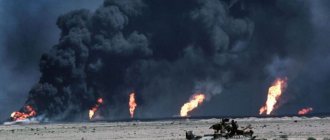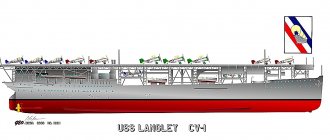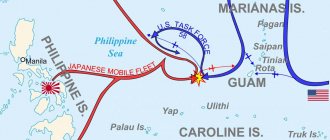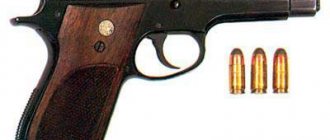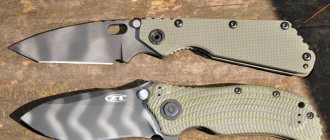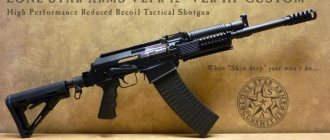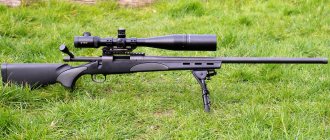2 605
The US Navy plans to place an order and acquire a new guided missile frigate in 2022.
Since the culling of the last ship of the Oliver Hazard Perry class in 2015, the US Navy no longer operates frigates for the first time since 1943. It was initially assumed that their tasks would be taken over by littoral combat ships (LCS), but this concept turned out to be insufficient. As a result, the Navy will stop purchasing both types of ships, LCS Freedom and Independence, after 32 ships, rather than after 52, as previously planned. In return, it is planned to purchase 20 traditional frigates.
Frigate of the Oliver H. Perry project
On the one hand, this decision was made due to the shortcomings of the LCS concept, and on the other hand, due to a change in priorities in the concept of war at sea. The changing security environment increased the importance of warfare on the high seas and justified the request for a new frigate.
The assumption that future warfare would take place in coastal waters has slowed the development of effective long-range weapons. However, the armament of LCS class ships turned out to be insufficient to completely replace traditional frigates. In addition, they do not have the ability to recover and remain in battle after being defeated by the enemy. A frigate, on the contrary, is capable of counteracting enemy missiles and is able to continue the battle even after being defeated by the enemy.
Freedom-class LCS ship
The new frigate is a multifunctional warship
It is planned that the new frigate, designed as a multifunctional ship, will be able to operate both in the open ocean and in coastal waters. It will take on numerous tasks that are currently forced on destroyers. Unloading destroyers will provide more efficient use of larger and more expensive ships and reduce the rate of deterioration of the fleet.
The frigate must effectively hit naval targets, combat submarines, have increased capabilities for conducting defensive and offensive electronic warfare (Electromagnetic Maneuver Warfare, EMW), and organize air defense on a unit-wide basis.
In the event of war, frigates will accompany troops and supply transports, and will also be able to integrate into combat formations. This class of ships will independently perform individual tasks at sea. In addition, in the future, frigates will be used in the lower threat spectrum: from partnership services and training of friendly navies, to counter-piracy and embargo enforcement.
US Navy destroyer enters the Black Sea
Likely combat capabilities
It is planned that the new frigate will receive the following characteristics and weapons systems:
- maximum speed of at least 26 knots;
- minimum capture of 16 air targets by SM-2 and EMMS anti-aircraft missiles (optimally 32 targets);
- long-range guided weapons (over-horizontal) for hitting sea targets, as well as the presence of a SeeRAM missile system for hitting sea targets at short range;
- sonar stations (HAS) AN/SLQ-61 and AN/SQS-62 and combat control system AN/SQQ-89F for anti-submarine warfare;
- control of air and surface space using phased array radar.
It is reported that COMBAT-21 (COMponent Based Total Ship System - 21 centry) has already been selected as the combat control system. It is a layered version of the Aegis system (AEGIS), but for small ships. For the defense of the formation and self-defense, the new frigate must have an air defense system of the Standard and ESSM (Evolved SeaSparrow Missile) families, a Nulka defense system, as well as an AN/SLQ-32(v)6 defensive electronic warfare system modifications of SEWIP Blok 2 (Surface Electronik Warfare Improvement Program).
Air defense system launcher "Standard"
The frigate will be able to exchange data with other ships for coordinated destruction of enemy targets (Cooperative Engagement Capability, CEC). The frigate's equipment package will include UAVs, surface and underwater uninhabited vehicles. This will increase the range of detection and destruction of the enemy with guided weapons, and also guarantees better counteraction to his reconnaissance means.
Dimensions and displacement are not specified. However, these characteristics are expected to provide the required capability profile and are likely to be no less than those of LCS ships.
Since the new frigate is equipped with heavy weapons, it will require a large crew. As a result, the calculated operating costs are estimated to be high. The US Navy command assumes a purchase price of between 800 and 950 million US dollars per ship (including on-board control systems, sensors and weapons). According to experts, this price is almost 50% higher than the current LCS class ship, but half the cost of one destroyer.
Self-defense system "Nulka"
Country: Australia, Bahrain, Egypt, Spain, Taiwan, Turkey, USA Country of origin: USA Ship class: frigate
Ship type: OLIVER HAZARD PERRY/ADELAIDE/SANTA MARHA/CHENG KUNG/ GAZIANTEP(FFG-frigate UR0)
In service: b Australia, 1 Bahrain, 4 Egypt, b Spain (Santa Magna class), 7 Taiwan (Cheng Kung class), Turkey (Gaziantep class)*, 39 USA
*Probably in 1999, the Turkish Navy will include three more Oliver Hazard Perry class ships from the US Navy, namely Tisdale (FFG 27), Reid (FFG 30) and plus Duncan (FFG 10) (for spare parts).
AUSTRALIA
Ship name and number: ADELAIDE (01), CANBERRA (02), SYDNEY (03), DARWIN (04), MELBOURNE (05), NEWCASTLE (06).
BAHRAIN
Ship name and number: SABHA (ex-JACK WILLIAMS) (90, ex-FFG 24)
EGYPT
Ship name and number: MUBARAK (ex-COPELAND) (F 911, ex-FFG 25), TAWA (ex-GALLERY) (F916, ex-FFG 26), EL ARISH (ex-FAHRION) (ex FFG 22), - , (ex-LEWIS IN PULLER), (ex-FFG 23) SPAIN
Ship name and number: SANTA MARHA (F 81), VICTORIA (F 82), NUMANCIA F 83), REINA SOFHA "ex-AMERICA) (F84), NAVARRA (F85), CANARIAS (F86)
TAIWAN
Ship name and number: CHENG KUNG (1101). CHENG HO (1103), CHI KUANG (1105), YUEH CHANG CHIEN(1109)
Türkiye
Ship name and number: GAZIAN-TEP (ex-CLJFTON SPRAGUE) (F490,ex-FFG 16),GIRESUN (ex-ANIRIM) (F491, ex-FFG 20), GEMLIK (ex-FLATLEY) (F 492, ex- FFG 21)
USA
Ship name and number: McINERNEY (FFG 8), WADSWORiH (FFG 9), CLARK (FFG 11), GEORGE PHILIP (FFG 12). SAMUEL ELIOT MORISON (FFG 13), JOHN H SIDES (FFG 14), ESTOCIN (FFG 15), JOHN A MOORE (FFG 19), BOONE (FFG 28), STEPHEN W GROVES (FFG 29), REID (FFG 30), STARK (FFG 39), JOHN L HALL (FFG 32), JARRET (FFG 33), UNDERWOOD (FFG 36), CROMMELIN (FFG 37), CURTS (FFG 38), DOYLE (FFG 39), HALYBURTON (FFG 40), McCLUSKY (FFG 41), KLAKRING (FFG 42), THACH (FFG 43), De WERT (FFG 45), RENTZ (FFG 46). NICHOLAS (FFG 47), VANDEGRIFT (FFG 48), ROBERT G BRADLEY (FFG 49), TAYLOR (FFG 50), CARY (FFG 51), CARR (FFG 52), HAWES (FFG 53), FORD (FFG 54), ELROD (FFG 51), SIMPSON (FFG 56), REUBEN JAMES (FFG 57), SAMUEL IN ROBERTS (FFG 58). KAUFFMAN (FFG 59), RODNEY M DAVIS (FFG 60), INGRAHAM (FFG 61)
Features:
• High bow with raised solid sides.
• SAM launchers and anti-ship missiles Standard and Harpoon in position “A” (on ships of the Taiwanese Navy, Hsiung Feng anti-ship missile launchers are installed at an angle between the masts. SAM launchers can only be in position “A”).
• Box-type superstructure with flat sides, located between the forecastle and the flight deck.
• The WM28 fire control radar antenna radome is visible on the bridge (on Spanish Navy ships - RCA Mk 92; on Taiwanese Navy ships - Unisys Mk 92). Directly behind the radome there is a lattice foremast on which the SPS-49 CC radar search antenna is installed.
• Forward amidships there is a large lattice mainmast.
• A 76 mm AU is installed in front of the chimney.
• The chimney has a low silhouette and is located at the rear of the superstructure.
• At the aft end the superstructure merges with the sides.
• On the roof of the hangar in the rear part there is a Vulcan Phalanx AU (the short-range Meroka AU is installed on Spanish Navy ships).
• On the sponsons adjacent to the superstructure and located in front of the chimney, 40 mm/70 AU Bofors are installed.
Total displacement, t: 4100 (4105, Taiwan). 3638 (Bahrain, Egypt,
Türkiye, USA FFG 9, 11-14,19, 30-31, 33). 3,969 (Spain).
Length, m: 138.1,135.6 (Bahrain, Egypt, Turkey, USA FFG 9.11-14.19, 30-31,
33). 137.7 (Spain).
Width, m: 13.7. 14.3 (Spain).
Draft, m: 4.5.
Speed, knots: 29.
Cruising range, miles: 4500 at a speed of 20 knots.
Missile weapons: McDonnell Douglas Harpoon anti-ship missiles. SAM GDC Pomona Standard SM-1MR; Mk 13 Mod 4 launcher for launching missiles and anti-ship missiles (2 quadruple Hsiung Feng I anti-ship missile launchers are installed on Taiwanese Navy ships. It is planned to install missiles with a rotating body on US Navy ships.
Cannon armament: 1 self-propelled gun OTO Melara Mk 75 Compact caliber 76 mm/62.1 self-propelled gun GE/GD/Vulcan Phalanx Mk 15 caliber 20 mm/76. Up to 6 12.7 mm machine guns (except Taiwan). (112-barrel Baz6n Meroka Mod 2A1 or 2B gun, caliber 20 mm/120, Spain) (2 additional 40 mm/70 Bofors guns; as well as 3 20 mm type 75 guns, which can be installed on the hangar roof, only on ships VMSTaiwan). (2 25-mm McDonnel Douglas Mk 38 guns on US Navy ships).
Torpedoes: 2 TTAs for Mk 32 torpedoes, 324 mm caliber. Honeywell Mk 46 Mod 5 torpedoes.
Decoys: 2 Loral Hycor SRBOC Mk 36 six-barreled gun mounts (on all ships). Towed anti-torpedo decoy Mk 6 Fanfare/SLQ-25 Nixie (Prairie Masker device for suppressing noise generated by the hull and propellers on Spanish Navy ships). (Kung Fen installation used for installing dipole reflectors, only on Taiwanese Navy ships.)
"SPARK"
Radar:
CC detection - Raytheon SPS-49(V)4 or 5. CC detection/navigation - ISC Cardion SP5-55. (Raytheon SPS-55 on Spanish Navy ships). Navigation - Furuno (Raytheon 1650/9 or SPS-67 on Spanish Navy ships). Fire control - Lockheed STIR (modified SPG-60). Sperry Mk 92 (Signaal WM 28). (RCA Mk 92 Mod 2/6, Signaal STING, Selenia RAN 30 L/X (RAN 12L + RAN 30X) on US Navy ships.) (UD 417 STIR (in US Navy service), Unisys Mk 92 Mod 6 on Navy ships Taiwan). GAS: Raytheon SQS-53B (DE 1160); located in the housing, active search and sighting. Towed passive sonar Gould SQR-18A (on Turkish Navy ships). Raytheon SQS-56; located in the building (Australia/Bahrain/Egypt). Raytheon SQS-56 (DE 1160) in the ship's hull and Gould SQR 19(V)2 towed tactical sonar (on Spanish Navy ships). Raytheon SQQ-89(V)2; located in the hull, active, search and sighting (on US Navy ships).
Helicopters: 2 Sikorsky S-70B-2 Seahawk helicopters or 1 Seahawk and 1 Aerospatiale AS 350B Squirrel PLO helicopter (Australia). 2 (1 in constant readiness) Sikorsky SH-70L Seahawk (LAMPS III) helicopter (Spain). 2 Sikorsky S-70C(M) Thunderhawks helicopters (1 in constant readiness) (Taiwan). 2 light multi-purpose helicopters Kaman SH-2G Seasprite (LAMPS 1) (Egypt/USA) or 2 LM helicopters Sikorsky SH-60B LAMPS Ш (ASW/TC/anti-aircraft control/over-the-horizon control) (on US Navy ships).
Table of contents
Offer options
The order to interested applicants for the detailed development of the Navy concept was issued on February 16, 2022. Within a year, applications from foreign manufacturers were approved. At the same time, as a mandatory condition, the customer set the requirement that ships be built exclusively in the United States.
The American shipbuilding company Huntington Ingalls Industries (HII) offers an armed version of a large patrol ship (National Security Cutter, NSC). The project was developed for the US Coast Guard and is suitable for operations on the high seas. The cruising range, dimensions and displacement meet the requirements for the new frigate. However, the armament is minimal compared to warships. In 2022, HII already presented a “Patrol Frigate”, designated by the developers of the NSC concept as the basic one.
Base ship of the Patrol Frigate project
The probable cruising range of the project will be up to 8 thousand nautical miles, maximum speed – 28 knots. The project includes 16 vertical launchers for SM-2 and ESSM missiles, eight Harpoon missiles and ASROC-ASW torpedoes. The ship will receive three torpedo tubes and a 76 mm deck gun.
The Marinette Marine (USA) and Fincantieri (Italy) enterprises are offering a project for a French-Italian-made multi-purpose European frigate, “Fregata Europea Multimissione” (FREMM), adapted to the needs of the United States. The European frigate has a reduced radar profile, 16 vertical launchers and can additionally carry anti-ship missiles.
Fremm project frigate
General Dynamics Bath Iron Works (GD/BIW, USA) together with Navantia-Izar (Spain) are working on a version of the Spanish frigate F-100. Unlike other contenders, the “output model” is already equipped with the Aegis combat control system. Tall superstructures are optimal for controlling long-range radars. The F100 project has 48 vertical launchers, but for the American version they will probably be reduced to 32.
Lockheed Martin demonstrates a modified project of the Freedom class ships. Initially, this option was designed for export. According to the concept sketch, the design will receive new add-ons, which will allow it to control a phased array radar. 16 vertical launchers can be placed next to the helicopter hangar or on the tank.
It is reported that Saudi Arabia has decided to develop it based on Freedom. Its goal is a new frigate designed to solve air defense tasks (“Multi Mission Combatant”). The Saudi version has eight vertical launchers.
Austal USA offers a heavily armed version based on the Independence project. This project is the only one designed as a trimaran. Vertical launchers and Harpoon missiles are located in the middle ship superstructure, as well as on the forecastle.
Independence class ship
The joint F 125 project from Atlas USA and Thyssenkrupp Marine Systems, the only one previously considered a promising candidate, is not participating in the competition. Since the US Navy does not publicly justify its decision, it is assumed that the reason was the catalog of shortcomings of this project compiled by the German Navy at the end of 2022.
Oliver Hazard Perry class frigates
Oliver Hazard Perry class frigates
FFG-7 “Oliver Hazard Perry” 12.6.1975 / 25.9.1976 / 17.12.1977 – disposed of 21.04.2006 FFG-8 “McInerney” 16.1.1978 / 4.11.1978 / 15.12.1979 – transferred to the Pakistan Navy, “Alamgir” ( F-260) FFG-9 “Wadsworth” 7/13/1977 / 7/29/1978 / 2/28/1980 – transferred to the Polish Navy, “Gen. T. Kos'ciuszko” FFG-10 “Duncan” 29.4.1977 / 1.3.1978 / 15.5.1980 – sold to Turkey FFG-11 “Clark” 17.7.1978 / 24.3.1979 / 9.5.1980 – transferred to the Polish Navy, “Gen . K. Pulaski" FFG-12 "George Philip" 12/14/1977 / 12/16/1978 / 10/10/1980 - disposed of 5.2004 FFG-13 "Samuel Eliot Morison" 12/4/1978 / 7/14/1979 / 10/11/1980 - transferred to the Turkish Navy, " Gokova” (F-496) FFG-14 “Sides” 7.8.1978 / 19.5.1979 / 30.5.1981 – disposed of, dismantled 01.25.2016 FFG-15 “Estocin” 2.4.1979 / 3.11.1979 / 10.1.1981 – transferred to the Turkish Navy, “Goksu” (F-497) FFG-16 “Clifton Sprague” 7/30/1979 / 2/16/1980 / 3/21/1981 – transferred to the Turkish Navy, “Gaziantep” (F-490) FFG-17 built for Australia as HMAS “Adelaide” (FFG-01) 29.7.1977 / 21.6.1978 / 6.11.1980 – scuttled 13.04.2011 FFG-18 built for Australia as HMAS “Canberra” (FFG-02) 1.3.1978 / 1.12.1978 / 21.3.1981 – scuttled 04.10.2009 FFG-19 “John A. Moore” 19.12.1978 / 20.10.1979 / 14.11.1981 – transferred to the Turkish Navy, TCG “Gediz” (F-495) FFG-20 “Antrim” 21.6. 1978 / 27.3.1979 / 26.9.1981 – transferred to the Turkish Navy, TCG “Gemlik” (F-492) FFG-21 “Flatley” 13.11.1979 / 15.5.1980 / 20.6.1981 – transferred to the Turkish Navy, TCG “Giresun” ( F-491) FFG-22 “Fahrion” 1.12.1978 / 24.8.1979 / 16.1.1982 – transferred to the Egyptian Navy, “Sharm El-Sheik” (F-901) FFG-23 “Lewis B. Puller” 23.5.1979 / 15.3.1980 / 17.4.1982 – transferred to the Egyptian Navy, “Toushka” (F-906) FFG-24 “Jack Williams” 25.2.1980 / 30.8.1980 / 19.9.1981 – transferred to the Bahrain Navy, “Sabha” FFG-25 “ Copeland" 10/24/1979 / 7/26/1980 / 8/7/1982 - transferred to the Egyptian Navy, "Mubarak" (F-911) FFG-26 "Gallery" 5/17/1980 / 12/20/1980 / 12/5/1981 - transferred to the Egyptian Navy, "Taba" ” (F-916) FFG-27 “Mahlon S. Tisdale” 19.3.1980 / 7.2.1981 / 27.11.1982 – transferred to the Turkish Navy, TCG “Gokceada” (F-494) FFG-28 “Boone” 27.3.1979 / 16.1.1980 / 15.5.1982 – decommissioned 2.2012 FFG-29 “Stephen W. Groves” 16.9.1980 / 4.4.1981 / 17.4.1982 – decommissioned 2.2012 FFG-30 “Reid” 8.10.1980 / 27.6.1981 / 19.2 .1983 – transferred to the Turkish Navy, “Gelibolu” (F-493) FFG-31 “Stark” 24.8.1979 / 30.5.1980 / 23.10.1982 – disposed of 21.06.2006 FFG-32 “John L. Hall” 5.1.1981 / 24.7. 1981 / 26.6.1982 – disposed of 3.2012 FFG-33 “Jarrett” 11.2.1981 / 17.10.1981 / 2.7.1983 – disposed of 5.2011 FFG-34 “Aubrey Fitch” 10.4.1981 / 17.10.1981 / 9.10.19 82 – scrapped 5.1999 FFG -35 built for Australia as HMAS “Sydney” (FFG-03) 16.1.1980 / 26.9.1980 / 29.1.1983 – decommissioned 7.11.2015 FFG-36 “Underwood” 30.7.1981 / 6.2.1982 / 29.1.1983 – disposed of 8.03.2013 FFG-37 “Crommelin” 30.5.1980 / 2.7.1981 / 18.6.1983 – disposed of 9.07.2016 FFG-38 “Curts” 1.7.1981 / 6.3.1982 / 8.10.1983 – disposed of 2.2013 FFG-39 “Doyle” 10.23.1981 / 5.22.1982 / 5.21.1983 – scrapped 7.2011 FFG-40 “Halyburton” 9.26.1980 / 10.13.1981 / 7.1.1984 – scrapped 9.2014 FFG-41 “McClusky” 10.21. 1981 / 18.9.1982 / 12/10/1983 – sunk as a target 07/19/2018 FFG-42 “Klakring” 2/19/1982 / 9/18/1982 / 8/20/1983 – disposed of 3.2013 FFG-43 “Thach” 3/6/1982 / 12/18/1982 / 17.3.1 984 – sunk as a target during exercise RIMPAC 2016 FFG-44 built for Australia as HMAS “Darwin” (FFG-04) 3.7.1981 / 26.3.1982 / 21.7.1984 – decommissioned 9.12.2017 FFG-45 “De Wert” 14.6.1982 / 18.12.1982 / 19.11.1983 – scrapped 4.2014 FFG-46 “Rentz” 18.9.1982 / 16.7.1983 / 30.6.1984 – sunk as a target during the exercise “Valiant Shield 2016” FFG-47 “Nicholas” 9/27/1982 / 4/23/1983 / 3/10/1984 – scrapped 3.2014 FFG-48 “Vandegrift” 10/13/1981 / 10/15/1982 / 11/24/1984 – scrapped 3.2015 FFG-49 “Robert G. Bradley” 12/28/1 982 / 13.8.1983 / 6/30/1984 – in 019 transferred to the Bahrain Navy FFG-50 “Taylor” 5/5/1983 / 11/5/1983 / 12/1/1984 – transferred to the Taiwan Navy (“Ming Chuan”) FFG-51 “Gary” 12/18/1982 / 11/19. 1983 / 17.11.1984 – transferred to the Taiwan Navy (“Feng Chiah”) FFG-52 “Carr” 26.3.1982 / 26.2.1983 / 27.7.1985 – disposed of 3.2013 FFG-53 “Hawes” 26.8.1983 / 18.2.1984 / 9.2 .1985 – scrapped 12.2010 FFG-54 “Ford” 16.7.1983 / 23.6.1984 / 29.6.1985 – sunk as a target 1.10.2019 FFG-55 “Elrod” 21.11.1983 / 12.5.1984 / 18.5.1985 - scrapped 1.2015 FFG -56 “Simpson” 2/27/1984 / 8/31/1984 / 9/21/1985 – disposed of 9/2015 FFG-57 “Reuben James” 11/19/1983 / 2/8/1985 / 3/22/1986 – destroyed as a target during a combat missile test 01/19/2016 FFG-58 “Samuel B. Roberts” 21.5.1984 / 12.12.1984 / 12.4.1986-disposed of 5.2015 FFG-59 “Kauffman” 8.4.1985 / 29.3.1986 / 02/28/1987-disposed of 9.2015 FFG-60 “Rodney M. Davis" 8.2.1985 / 11.1.1986 / 9.5.1987 - scrapped 3.2015 FFG-61 "Ingraham" 30.3.1987 / 25.6.1988 / 5.8.1989 - scrapped 1.2015
Australian-built frigates: FFG-05 “Melbourne” 12.7.1985 / 5.5.1989 / 15.2.1992 FFG-06 “Newcastle” 21.7.1989 / 21.2.1992 / 11.12.1993
Spanish-built frigates: F81 “Santa María” 22.5.1982 / 24.11.1984 / 12.10.1986 F82 “Victoria” 16.8.1983 / 23.7.1986 / 11.11.1987 F83 “Numancia” 8.1.1986 / 29.1.1987 / 8.11.1988 F84 “Reina Sofía” 10/12/1987 / 7/19/1989 / 10/30/1990 F85 “Navarra” 4/15/1991 / 10/23/1992 / 5/30/1994 F86 “Canarias” 4/15/1992 / 6/21/1993 / 14/12 .1994
Taiwan-built frigates: FFG-1101 “Cheung Kung” 2.12.1990 / 5.10.1991 / 7.5.1993 FFG-1103 “Cheng Ho” 3.11.1991 / 15.10.1992 / 28.3.1994 FFG-1105 “Chi Kuang” 4.10.199 2 / 27.9.1993 / 7.3.1995 FFG-1106 “Yueh Fei” 5.9.1993 / 26.8.1994 / 6.2.1996 FFG-1107 “Tzu I” 7.8.1994 / 13.7.1995 / 9.1.1997 FFG-1108 “Pan Chao” ” 17.1.1995 / 4.7.1996 / 12.12.1997 FFG-1109“ Chang Chien ” 4.12.1996 / 14.5.1997 / 12/12/1998 “ Tian Dan ” 21.2.2001 / 10.2002 / 9.3.2004
URO frigates of the “OLIVER HAZARD PERRY” type, one of the largest series of escort ships built in the United States after the end of World War II. The total number of OLIVER H. PERRY class frigates built in the USA is 55 ships, of which 51 were built for the US Navy and 4 for the Australian Navy.
Two ships of this type were built in Australia, six in Spain and seven in Taiwan. Several frigates withdrawn from the US Navy were sold to Turkey, Egypt, Bahrain and Poland.
During the reconstruction, the Australian Adelaide-class frigates received a Mk41 launcher with 8 cells (one module) that accommodate 32 ESSM anti-aircraft missiles. In total, the Australian Navy has 4 frigates of this type in service; two more frigates that have not undergone reconstruction have been withdrawn from the fleet. The reconstruction of the Adelaide-class frigates is considered the most unsuccessful in the history of the Australian Navy.
Length: 135.9 m Width: 13.5 m Draft: 6.7-7.77 m Displacement: 4100 tons Cruising range: 4500 miles (at 20 knots), 5000 (at 18 knots). Crew: 287 Speed: 33.4 knots ARMAMENT Guns: 1 MK 75 Torpedo tubes: 6,324 mm Anti-ship systems: 4 Harpoon Anti-aircraft guns: 1 Vulcan MK.15; 1 Standard Helicopters: 2 Electronic weapons GAS: 1 AN/SQS-56 Radar: 1 AN/SPS-49 Fire control systems: 1 MK92 Crew: 219 people (including 19 officers)
Preliminary estimates
According to publications, all candidates offer variants of ship types already in operational use. This is consistent with the US Navy's policy to return to "proven and proven technologies" in this program. In this context, “proven” means that the technologies have already been used or are declared ready for use.
This approach is expected to keep project costs, time and risks within reasonable limits. In any case, each of the “base models” will undergo the necessary adaptation to the special requirements of the US Navy. The final decision on the contract will take place in two years. Until then, it will remain possible to refine the design and rework suspected weak points several times.
European proposals
According to experts, as of mid-2022, the Fremm and F100 projects best meet the Navy’s requirements.
The first Fremm-class frigate was delivered to the French Navy in 2012. Since then, 13 ships have been in service. The standard ship of the F100 project, Alvaro de Bazan, joined the Spanish fleet in 2002. On its basis, the Norwegian frigate Nansen and the Australian Navy destroyer project Hobart were developed and built.
Preliminarily, both European proposals are associated with the least technical risk, which could have a positive impact on the timeline. However, the Spanish ship's chances are negatively affected by delays in the development and delivery of the Australian Hobart class. What speaks against the Alvaro de Bazan is its current price (about $1.2 billion per ship), which blows up the established framework of the American frigate program.
F100 "Alvaro de Bazan"
American applications
According to experts, the prospects for both variants of the LCS class, on the contrary, are constantly narrowing. In April 2022, the Navy announced that all planned LCS departures for that year were likely to be eliminated. This is a consequence of technical defects.
Waiting problems, as well as the new focus of combat training, are slowing down the bringing of crews to combat readiness. The corps of LCS skeptics both inside and around the Pentagon is quite large. Many are questioning whether it is necessary to install a new frigate on the base of a ship of a type whose procurement program has been sharply reduced due to insufficient efficiency and technical defects.
When saving is dangerous for a ship: the truth about the frigates "Oliver H. Perry"
A shroud of sea foam was all that this frigate expected when meeting the enemy.
Last week, my esteemed colleague listed the advantages of the Oliver Perry and elevated it to the standard of naval weapons. It turned out that many of the ideas implemented during the creation of the Perry needed to be used in the construction of domestic warships.
But were those ideas really that useful?
And will there be any benefit from a ship designed with an eye to a foreign frigate from a past era?
We need to stop seeing Perry as a simple, cheap and therefore mass-produced ship.
It became widespread not because it was cheap. And it was cheap not because it was planned to become mass-produced. Logic based on domestic examples does not work in the case of Perry.
Serial construction of frigates (51 for the US Navy) was carried out in the period 1977-1989. Over the same period of time, the fleet was replenished with... 53 warships of the “cruiser” and “destroyer” classes!
31 Spruance and 14 Ticonderoga - up to 1989 inclusive. Plus the “white elephants”, by chance the destroyers Kidd, the strongest in their class, found themselves under the striped flag. And hi-end “exotic” - four nuclear-powered cruisers "Virginia".
Only modellers can distinguish "Kidd" from "Spruance". The third representative of the family, the guided missile cruiser Ticonderoga, was unified with destroyers in most systems
That's the whole truth about simple and cheap "workhorses". If the bulk of the Navy really consisted of 4,200-ton ships of simplified design, designed according to the methods of "Oliver Perry", such a fleet would be worthless.
In addition to 53 cruisers and destroyers of new projects, the US Navy included over 20 missile cruisers, Kunz/Feregat missile destroyers and other serious equipment of past decades. As of the mid-to-late 80s, the number of large warships actually exceeded the number of “cheap and mass-produced” frigates.
Just as in our time, the number of Burks built is four times the number of smaller LCSs.
The Perry frigates were cheap because they were going to perform a limited range of tasks, behind the backs of their senior colleagues. And 51 of them were built, because the Yankees considered it necessary to have just such a number of auxiliary ships.
No one was chasing numerical records and mass numbers.
The choice of "Perry" as a standard in the design of future Russian ships can cause nothing but a smile
Taking into account the role and purpose of the project, further questions about the technical side of the ship disappear.
The forced compromises in its design did not come as a surprise to the customer. With a given displacement based on the technological backlog of the 70s, the frigate was obliged to be inferior in combat capabilities to cruisers and destroyers.
The appearance of “Perry” was chosen not by a computer, but by real people. In their ideas about the frigate as a single-shaft ship with a sharp clipper bow, simple chopped superstructure shapes and a transom stern with a displacement of approx. 4000 tons, the creators of the Perry were guided by its predecessors - the Knox-class anti-submarine frigates. Taking these preferences into account, the computer calculated the exact dimensions and helped select the optimal layout of compartments and mechanisms. But the trends were set by the people themselves, with an eye on existing projects of similar sizes.
"Perry" and "Knox"
Its predecessors, the Knox, were created to escort convoys in the third world war. Where the only enemy on transatlantic routes could only be Soviet submarines.
With a displacement of 4000 tons, the frigate Knox was fully suitable for its purpose. Considering the volume and complexity of the work ahead, it was a very expensive ship, carrying the most sophisticated anti-aircraft defense equipment of that time.
“Knox” didn’t know how to do anything else, and until the end of his days he never learned anything.
As for the Perry, its creators used a hull similar in size to the Knox to create a ship for everyday service in the Cold War, which was supposed to enter local conflict zones, where every discovered boat and aircraft could be a carrier of an anti-ship missile . Where they could shoot from the shore. Where at any moment a battle could break out with the “mosquito forces” of an unpredictable enemy (who was considered an ally in the morning). Where the ship might be required to provide artillery support to forces ashore. Or a lightning strike on the deck of an enemy corvette, using a missile defense system with a disabled proximity fuse.
The Yankees considered a frigate with a primitive two-dimensional radar and a single-channel air defense system acceptable for these purposes. In the absence of full-fledged countermeasures and electronic warfare.
In addition, the frigate was equipped with a single “Phalanx” covering the stern corners, i.e., in the language of experts, it had an open air defense contour.
Taking into account the “one-armed” launcher and the accepted consumption of two missiles per target, the frigate had every chance of not surviving a meeting even with a couple of enemy aircraft. However, like any other ship of its size, built using technologies of the 1960-1970s.
The customer received exactly the kind of frigate that the Navy required: an auxiliary unit of the second or even third rank, on which it was a pity to spend an extra cent.
The safety of the Perry was not guaranteed by the strength of its weapons or the training of its crew. Let us paraphrase the Soviet commander, who proudly responded to the provocative calls of NATO ships: “You are sailing in a dangerous direction.” — Our safety is ensured by the flag of the Soviet Union!
It was not difficult to gouge Perry. It is then difficult to survive under sanctions. However, one day this logic did not justify itself.
The consequences of the attack on Stark do not contain sensational overtones
Such a ship could not sink from hits from a pair of Exocets; all damage occurred above the waterline.
The fire that arose from the engine of the anti-ship missile stuck in the superstructure was effectively dealt with by the explosion of the second Exocet. Which, paradoxical as it may sound, even made the frigate’s situation easier. Unlike Sheffield, which was damaged at the ends of the earth, Stark was located near the American base in Bahrain, where it was brought the next day.
As for the general assessment of survivability, the Perry frigates received a superstructure made of fire-hazardous aluminum-magnesium alloys, traditional for that time. Subsequently, this decision was considered unacceptable, and such ships have not been built for a long time.
The single-shaft design of the power plant is another compromise. The creators of "Perry" considered this decision justified for a second-rate 2-rank unit.
My colleague’s statement about the absence of an impact on survivability when using a single- or two-shaft power plant scheme is contrary to common sense. It is interesting how the experience of using single-shaft ships during WWII was analyzed, if warships of the main classes with a single-shaft power plant simply did not exist.
Even the smallest destroyers of that time, with a displacement of approx. 2000 tons were equipped with a two-shaft power plant.
Of course, the two-shaft power plant radically increased survivability. There are a great many cases of combat damage to a propeller on one shaft or destruction of engine rooms on one side. At the same time, the ships retained the ability to set sail. An example is the second cruise of the cruiser “Red Caucasus” to Feodosia.
Is it worth looking for meaning where there is none?
The Oliver Perry-class frigate was programmed to defeat.
The only question was whether we were ready to give him a fight. As time has shown, none of his opponents had the resolve (or need) to attack small ships. The unique incident with “Stark” has remained a mystery of history. Who gave the crazy order and for what purpose? In addition to compromises, the Perry design also contained positive elements. Among them is a set of technical means under the abbreviation LAMPS, which made it possible to link together all the anti-submarine weapons of the frigate, including search and targeting systems on board helicopters. When criticizing the Perry, we must not forget about the scientific and technical level of the country in which that ship was created.
The Oliver Perry's fatal inherent flaw was its mediocre seaworthiness. In fresh weather, when pitching, the bow of the frigate appeared out of the water, which was followed by a terrible blow (bottom slamming). In addition to the loss of functionality of sonar equipment, constant impacts destroyed the already fragile structure, causing multi-meter cracks in the superstructure.
This had nothing to do with the size of the Perry; it, like any ship, was small only on paper. The reason for the slamming was that the hull elongation was too large (9.7), which made it possible to get by with less power from the power plant at full speed. And, probably, errors in the design of the contours.
Apparently, the computer did not take something into account when calculating.
Dimensions of the ship with a displacement of approx. 4000 tons compared to a person. In the illustration: sailors wash away pacifist activists climbing the anchor chain. This is happening in Denmark, at the American base they would have been shot
At the beginning of the new century, the Perrys underwent extensive modernization: the “one-armed bandit” was removed from their decks, and a patch was welded in its place. Left without missile weapons, they began to gradually be withdrawn from the fleet.
If twenty years ago the decommissioned Perrys were a welcome gift for US allies, today they are of no interest even to them. Modern ships have long had a different look and are built to different standards.
Oliver Perry-class frigate and Spruance-class destroyer
Ukraine
Anti-aircraft missile weapons The basis of the ships' anti-aircraft weapons was the Standard anti-aircraft complex, designed to fire RIM-66 SM-1MR medium-range missiles.
The missiles were launched from the Mk-13 single-boom rapid-fire bow launcher: the reload rate of the installation was one shot every eight seconds. An ammunition supply of forty missiles was stored in two rotating drums located one inside the other. The outer drum contained 24 missiles, the internal one - 16. The missiles were guided using the Mk-92 “Tartar” control system, target designation was carried out by a single AN/SPG-51 radar located on a stand in the center of the superstructure. Thus, no more than one target could be attacked at a time, albeit with an unlimited number of missiles. The capabilities of the complex ensured the destruction of air targets at a distance of up to 50-75 kilometers, depending on the modification of the missile used.
Due to the decommissioning of obsolete RIM-66 SM-1MR anti-aircraft missiles in the 2000s, and the high cost of upgrading to new SM-2MR missiles, the US Navy decided to dismantle the launcher from all of its frigates. Thus, the capabilities of the ships were reduced de facto to anti-submarine defense and self-defense from air attack.
Anti-ship weapons Although the Oliver Hazard Perry frigates were not intended to engage in combat with surface enemies (since they were considered primarily as ocean-going escorts), they could nevertheless use RGM-84 Harpoon anti-ship missiles. In this case, the missiles were loaded into the drum magazines of the Mk-13 bow launcher instead of part of the anti-aircraft missiles, and were launched from the beam. As a result, the intervals between launches of anti-ship missiles were somewhat longer than in conventional container installations.
Also, SM-1MR anti-aircraft missiles could be used to destroy surface targets within the radio horizon.
Artillery weapons The artillery weapons of the Oliver Hazard Perry class frigates are the OTO Melara gun mount with a caliber of 76 millimeters, manufactured under license from an Italian company. This compact, rapid-firing weapon provides a rate of fire of up to 85 rounds per minute, which makes it more convenient for air defense purposes than 127-millimeter guns, but the cannon's light projectile is practically incapable of effectively hitting large ships and ground targets.
Since the bow of the ship is occupied by an anti-aircraft missile launcher, and the stern by a helicopter deck, an unusual placement was proposed for the gun mount on the roof of the superstructure, almost in the center of the frigate’s hull. As a result, the installation de facto has firing sectors only on the sides: the forward firing sector is blocked by the mast, and the stern – by the frigate’s chimney. As a consequence, the efficiency of the installation is limited.
The frigate's additional anti-aircraft armament is the Vulcan-Phalanx missile launcher, mounted on the roof of the superstructure between the frigate's helicopter hangars. The installation is designed to finish shooting aircraft and anti-ship missiles breaking through to the ship: however, for technical reasons, its field of fire is significantly limited and does not control the bow angles (which was one of the reasons for the incident with the defeat of the Stark frigate).
Anti-submarine weapons The anti-submarine weapons of the frigates consist of two built 324-mm. Mark 32 SW torpedo tubes, aimed primarily at self-defense. Due to lack of weight and deck space, the ships are not equipped with the ASROC anti-submarine missile torpedoes that were installed on previous American frigates.
Aviation weapons For their small size, frigates of the Oliver Hazard Perry class had very powerful aviation equipment. Their aft part was completely occupied by the flight deck, and at the rear of the superstructure, two hangars for helicopters were located side by side. The first ships (short hulls) carried multi-role Kaman UH-2 Seasprite helicopters, while later ones had a longer hull and larger hangars specifically to accommodate two more advanced Sikorsky SH-60 Seahawks.
The main task of the helicopters is anti-submarine defense of a convoy escorted by a frigate, rescue and transport operations. For this purpose, helicopters are equipped with anti-submarine torpedoes, depth charges and drop-dropping sonobuoys. To a limited extent, helicopters can also be used to attack ships (without powerful air defense) and ground targets using AGM-119 Penguin anti-ship missiles and AGM-114 Hellfire missiles.
Which frigates will become the main ones in the navies of the USA, China and Russia
In mid-February 2022, five shipbuilding corporations - Austal USA, Lockheed Martin, General Dynamics Bath Iron Works, Fincantieri Marine, and Huntington Ingalls Industries - received contracts to develop the FFG(X) advanced guided missile frigate for the US Navy . The winner will be determined in late spring of this year. Defense News writes about this.
The companies were given 16 months to develop the project. The results of the conceptual design will be announced at the end of spring this year, and the contract for the construction of the ships will be concluded in 2022. The first FFG(X) is expected to be ready in 2022. In total, it is planned to build at least 20 frigates of this project.
The US Navy has requested $1.3 billion for the first FFG(X) hull in 2022 and has said each subsequent frigate should cost in the region of $800 million per unit. For comparison: one guided missile destroyer of the Arleigh Burke type Flight IIA+ costs about $1.8 billion, and one combat ship of the LCS-1/LCS-2 type costs about $588 million. In other words, the promising guided missile frigate FFG(X) is by no means cheap.
The appearance of FFG (X) began to emerge back in 2014. The first tactical and technical requirements for this frigate suggested that it would be a relatively small, well-armed and survivable ship. In 2022, the US Navy clarified its views on the promising frigate. The new requirements suggested the emergence of a ship with significantly greater combat capabilities than just an LCS (littoral combat ship, or coastal ship) with a large number of weapons.
The five designs in the competition represent a variety of new frigate options, from Lockheed Martin's littoral combat ship to Austal USA's trimaran version.
Among the favorites in this race, US experts call either the Fincantieri frigate FREMM or the updated LCS version of the Lockheed Martin corporation. It is expected that the construction of ships of this type will begin at Lockheed Martin's Marinette Marine shipyard in Marinette, Wisconsin.
Others believe that the project of the shipbuilding corporation Huntington Ingalls, or even the company Austal, whose frigate is the only one among the competitors with an aluminum hull, may be among the leaders. In general, the winner will be determined soon.
As a combat information and control system on the promising frigate, it is planned to deploy the Aegis version - AEGIS Baseline 10. The ship will be equipped with a lightweight version of the AN/SPY-6 air defense and missile defense radar, which is currently fully installed on the Arleigh guided missile destroyers Burke" Flight III.
The frigate will also receive an anti-torpedo protection system for surface ships of the NIXIE AN/SLQ-25E type, an advanced electronic warfare system of the AN/SLQ-32 type, and a multifunctional sonar with a towed antenna array.
The promising ship will be armed with 32 unified ship-based vertical launch systems for a variety of guided missiles (it is possible to use RIM-162 ESSM Block 2 and/or long-range missiles RIM-67 (SM-2), RIM-156A/B (SM-2ER Block IV) , RIM-174 ERAM (SM-6).
In addition, the new frigate is expected to receive eight launchers of so-called over-the-horizon anti-ship cruise missiles. What this could be is not yet entirely clear. Most likely, either Harpoon Block II/Block II+, or NSM, or Lockheed Martin LRASM. As they say, options are possible.
The ship's artillery will be represented by a 57-mm Mk110 artillery mount (presumably, the ammunition load will include new inexpensive so-called smart ammunition - shots with guided high-explosive fragmentation warheads).
And this, of course, is not a complete list of the weapons, military equipment and equipment that FFG (X) will receive.
The total displacement of the frigate FFG (X) will probably be at least 4 thousand tons. The crew is about 200 people.
How China and Russia will respond
The Chinese are not lagging behind the United States in increasing their naval power. The first of the promising Chinese guided missile destroyers of Project 055, named Nanchang, appeared at the naval parade in April 2022 in honor of the 70th anniversary of the People's Liberation Army Navy in the waters of the Qingdao naval base with the participation of Chinese leader Xi Jinping. This event was not complete without the first Chinese aircraft carrier, Liaoning, which is a refurbished Soviet-era ship.
The Qingdao parade featured 18 warships from 13 other countries, including Russia, Australia, India and Japan. It is noteworthy that the United States declined the invitation to send its ships to this naval parade.
And the invitation of the French Navy was withdrawn by the Chinese side after the French frigate Vandemeyer passed through the Taiwan Strait before this event. Beijing accused Paris of allowing its ship to "illegally enter Chinese waters." By the way, this is the first time that China has officially designated the Taiwan Strait as Chinese waters.
The guided missile destroyer Nanchang began construction at the Shanghai Jiangnan Changxin shipyard in June 2022. The length of the Project 055 destroyer, classified by the Pentagon as a cruiser, is almost 180 m, the ship has a displacement of 12 thousand tons. Some naval analysts believe that in fact the displacement of the Nanchang is even greater. The destroyers of this project will be the largest in the world after the American Zamvolt-class destroyers.
The Chinese ship is equipped with 112 unified vertical launch systems that are capable of launching surface-to-air missiles (or anti-ship missiles), and a modern sensor suite, including phased array radars.
Speaking at a regular press briefing held by the Chinese Ministry of National Defense on Thursday, Senior Colonel Ren Guoqiang confirmed that the Nanchang is at the stage of completing sea trials and will be officially handed over to the PLA Navy later this year. A total of 16 destroyers of this type are planned to be built.
In addition to the Nanchang, recent satellite and aerial photographs show that seven more Project 055 destroyers are in various stages of construction at China's two main naval shipyards in Shanghai and Dalian. In addition, the first aircraft carrier built entirely in China, which still shares similarities with the Liaoning, is currently being completed.
Finally, photographs show another five smaller Type 052D destroyers being built in Dalian, and six more ships being built in Shanghai. The latter shipyard has assembled four more destroyers of an unknown subtype, and has also reportedly secured sections for the hull of China's third and largest aircraft carrier.
As for Russia, the frigates of Project 22350 “Admiral Amelko” and “Admiral Chichagov” were laid down at a shipbuilding plant in St. Petersburg the other day. The displacement of the ships of this project is 4.5 thousand tons, and the main armament is 16 or 24 standardized vertical launch systems for Kalibr-NK missiles. So far, Russian ships do not have strategic missile defense capabilities.
